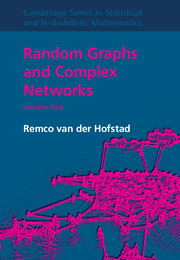Preface
Published online by Cambridge University Press: 12 January 2017
Summary
In this book, we study random graphs as models for real-world networks. Since 1999, many real-world networks have been investigated. These networks turned out to have rather different properties than classical random graph models, for example in the number of connections that the elements in the network make. As a result, a wealth of new models were invented to capture these properties. This book summarizes the insights developed in this exciting period.
This book is intended to be used for a master-level course where students have a limited prior knowledge of special topics in probability.We have included many of the preliminaries, such as convergence of random variables, probabilistic bounds, coupling, martingales and branching processes. This book aims to be self-contained. When we do not give proofs of the preliminary results, we provide pointers to the literature.
The field of random graphs was initiated in 1959–1960 by Erdős and Rényi (1959; 1960; 1961a; 1961b). At first, the theory of random graphs was used to prove deterministic properties of graphs. For example, if we can show that a random graph with a positive probability has a certain property, then a graph must exist with this property. The method of proving deterministic statements using probabilistic arguments is called the probabilistic method, and goes back a long way. See among others the preface of a standard work in random graphs by Bollobás (2001), or the classic book devoted to The Probabilistic Method by Alon and Spencer (2000). Erdős was one of the pioneers of this method; see, e.g., Erdős (1947), where he proved that the Ramsey number R(k) is at least 2k/2. The Ramsey number R(k) is the value n for which any graph of size at least n or its complement contains a complete graph of size at least k. Erdős (1947) shows that for n ≤ 2k/2 the fraction of graphs for which the graph or its complement contains a complete graph of size k is bounded by 1/2, so that there must be graphs of size n ≤ 2k/2 for which neither the graph nor its complement contains a complete graph of size k.
The initial work by Erdős and Rényi on random graphs has incited a great amount of work in the field, initially mainly in the combinatorics community.
Information
- Type
- Chapter
- Information
- Random Graphs and Complex Networks , pp. xi - xivPublisher: Cambridge University PressPrint publication year: 2016
